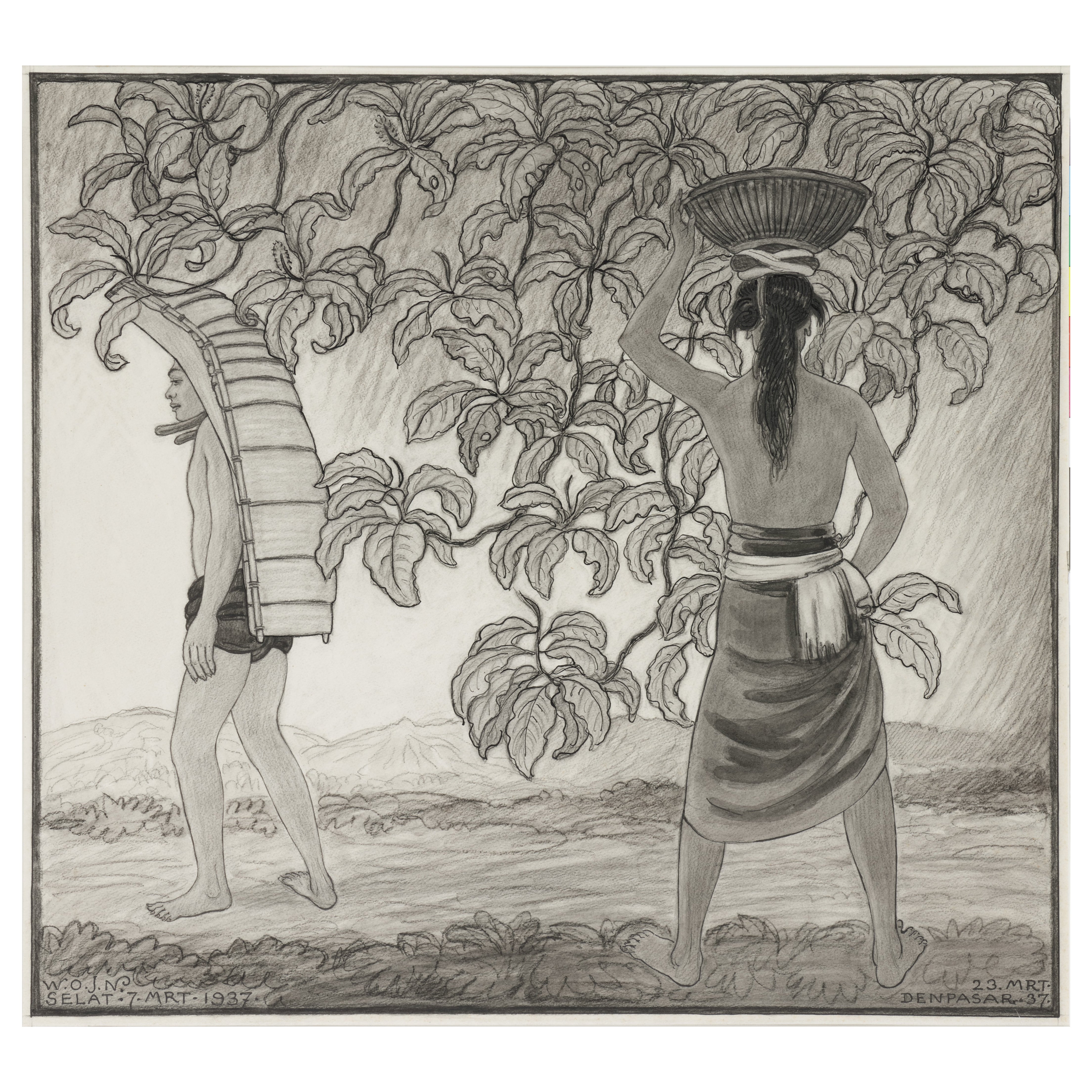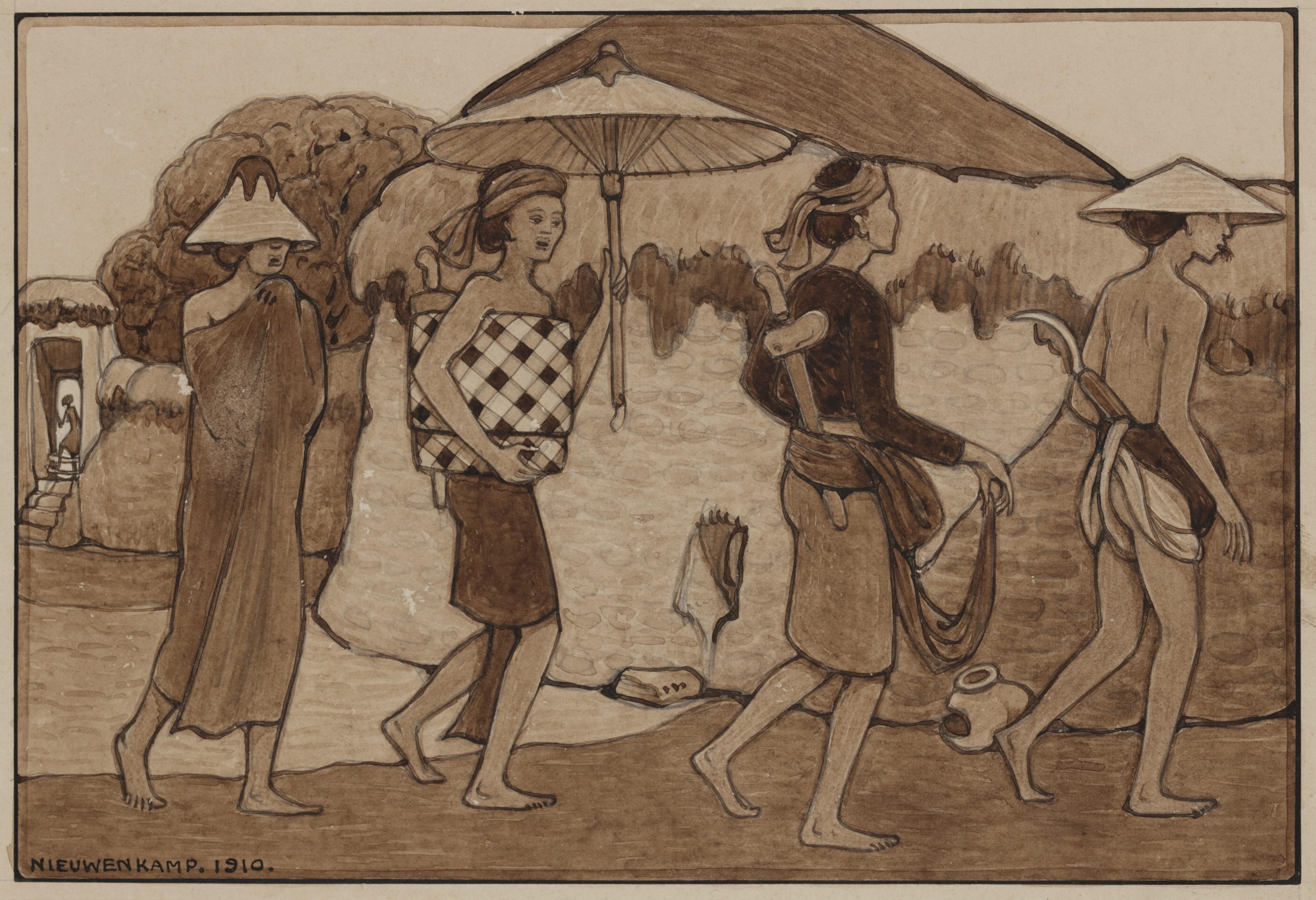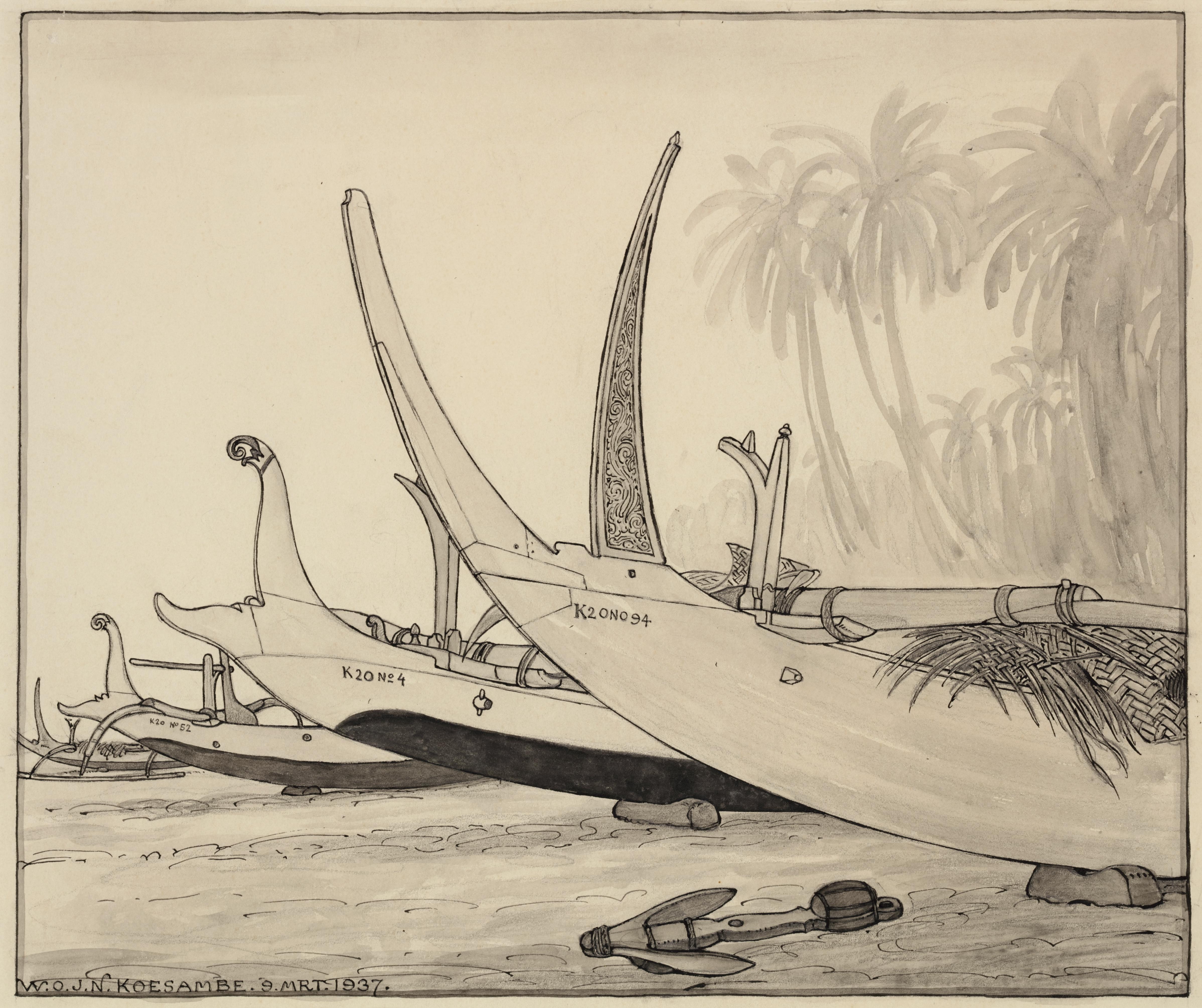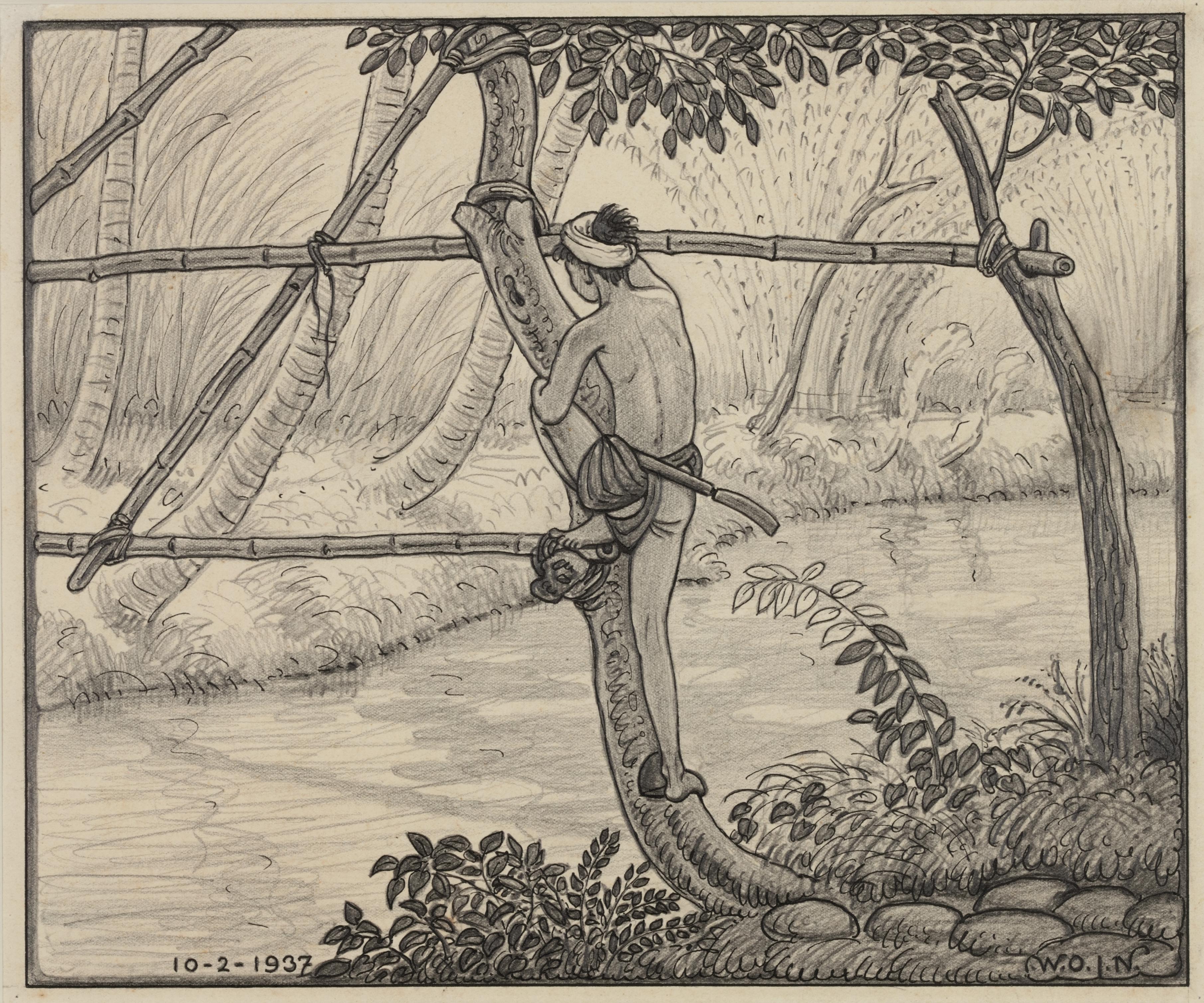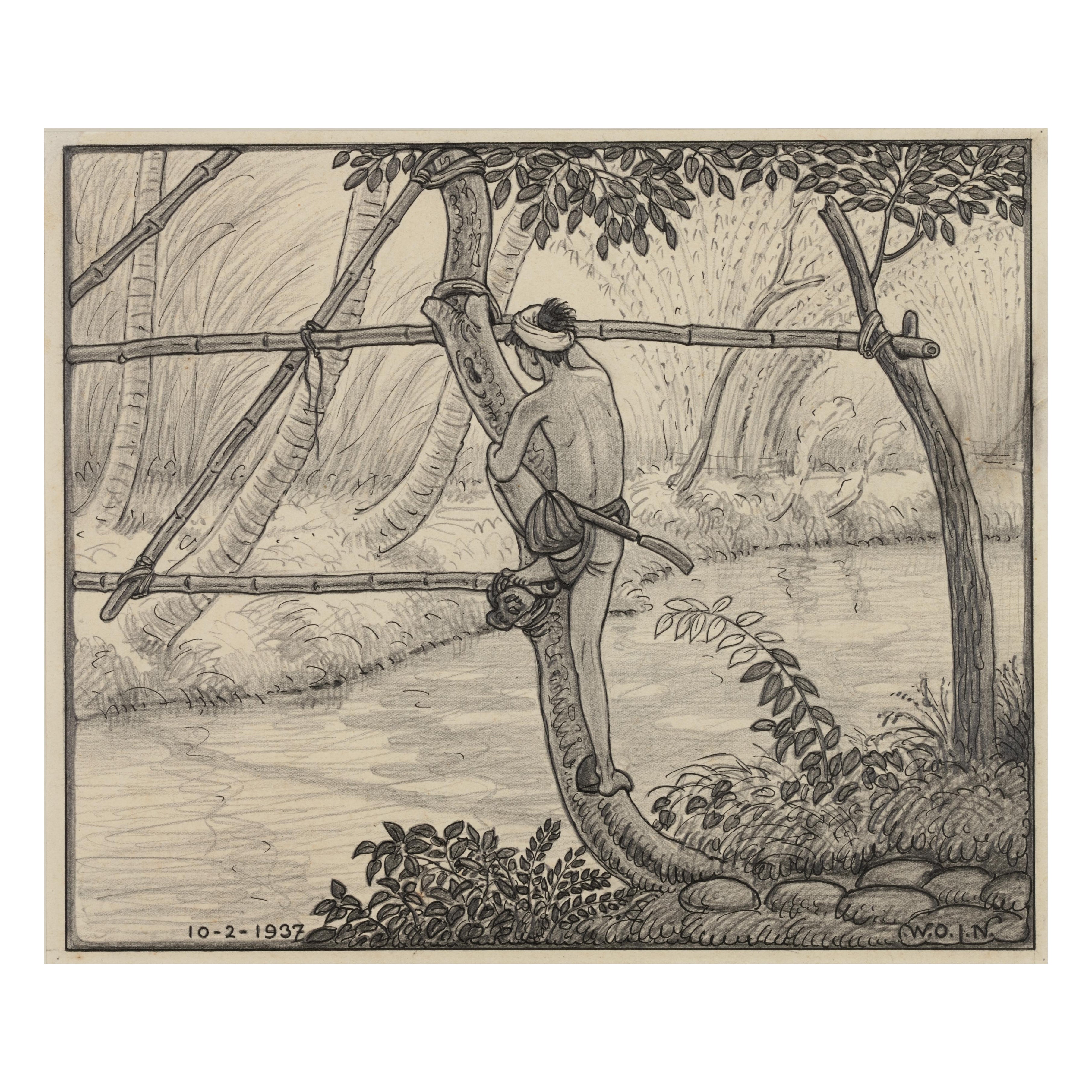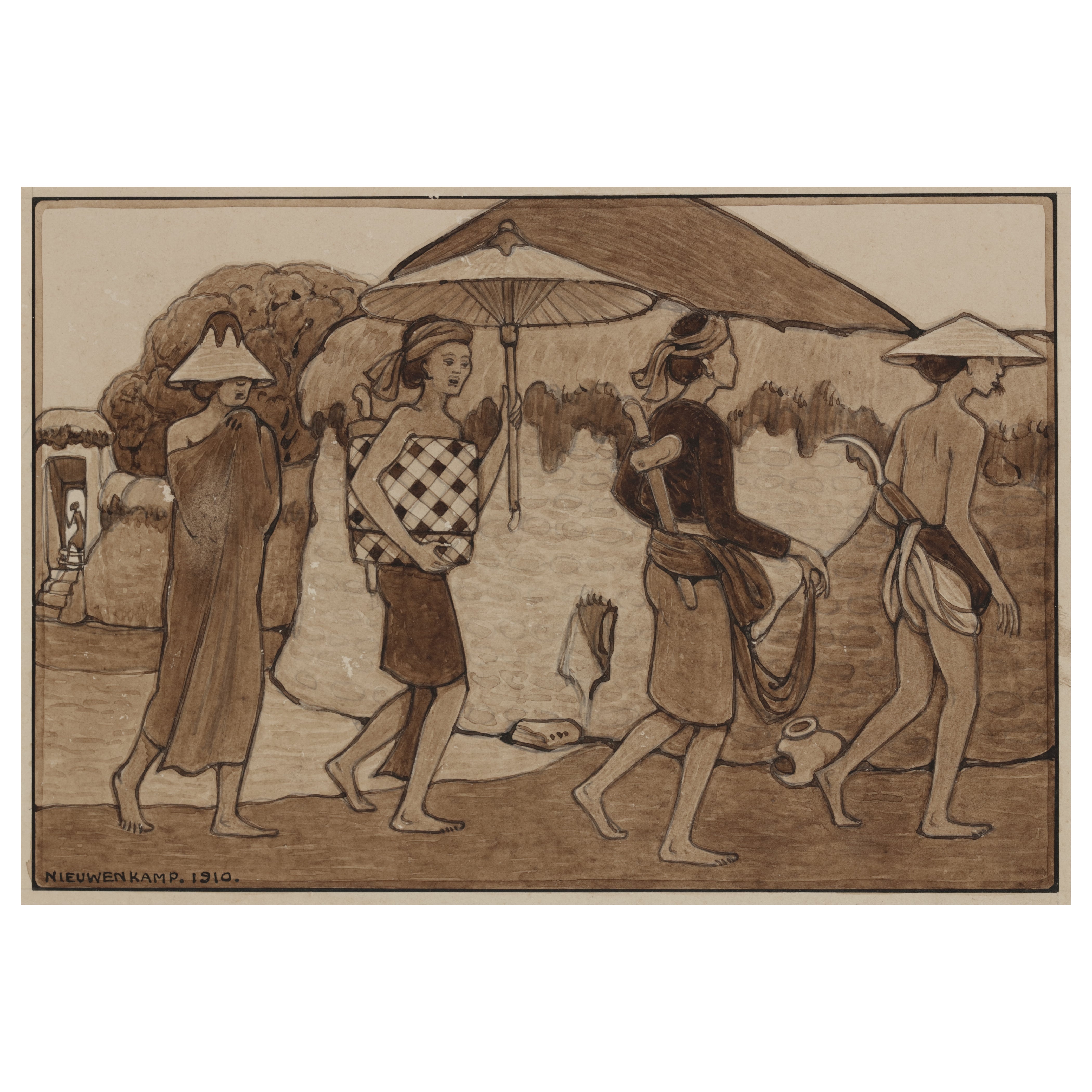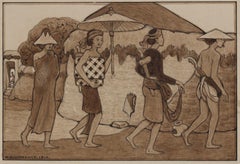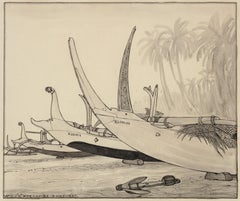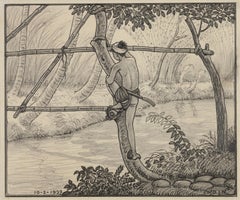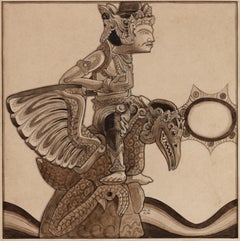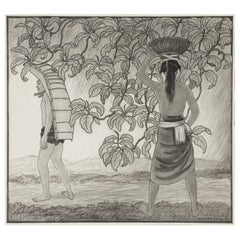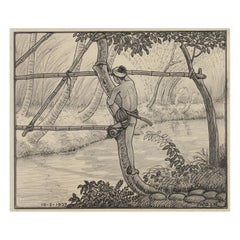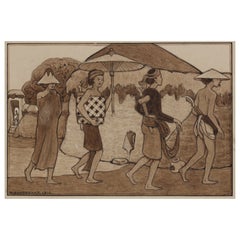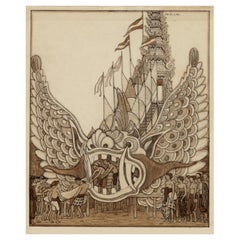Items Similar to Incoming Rain, Bali, 1937
Want more images or videos?
Request additional images or videos from the seller
1 of 2
W.O.J. NieuwenkampIncoming Rain, Bali, 19371937
1937
$21,675.35
£16,037.05
€18,000
CA$29,970.03
A$32,903.36
CHF 17,165.75
MX$398,176.47
NOK 215,146.07
SEK 202,724.16
DKK 137,052.50
About the Item
Incoming rain, Den Pasar, Bali 1937
Signed with initials, dated and titled, bottom right
Black chalk and ink on paper, 42 by 46 cm
Literature:
Ernst Braches en J.F. Heijbroek, W.O.J. Nieuwenkamp, Bouwstoffen, toegepaste grafiek en illustraties, Amsterdam 2016, p. 383
Black ebonized frame with white mount
Willem Otto Wijnand Nieuwenkamp (1874-1950)
Nieuwenkamp was born on July 27th 1874 in Amsterdam. His father owned sailing ships sailing to Indonesia and hearing the stories of the returning captains evoked in the young Nieuwenkamp an obsession for distant lands and adventure. After a failed attempt by his father to have his son make a career in his business, Nieuwenkamp attended the Academy for Decorative Art in Amsterdam. However, he left within one year to go his own way.
He was an autodidact and a great experimenter with new techniques, particularly in the art of etching. Nieuwenkamp was a very focused man with the discipline of a scientist tempered by the sensitivity of an artist, a lust for adventure, a natural appreciation for ethnic arts and an enormous ambition to tread new paths.
In 1898 he visited Indonesia for the first time and on his second visit in 1903-1904 he went on to Bali and became the first foreign artist to love Bali and the Balinese with a passion. Having secured agreements with several museums in the Netherlands to obtain Balinese art and objects for their collections, Nieuwenkamp immediately started to purchase and order a wide range of ethnographic art and objects from local artists and craftsmen.
Through his drawings and books, he gave an excellent impression of Balinese art and culture at that time. Since 1854 Northern Bali was under Dutch rule but Southern Bali in 1904, when Nieuwenkamp visited it, was still independent. Nieuwenkamp would be one of the last Westerners to experience a glorious medieval society in its final days. During his second visit to Bali in 1906 the Dutch decided to end the independence of South Bali and Nieuwenkamp was invited by the Governor-General van Heutz to accompany the Dutch invasion force. By contemporary European standards, the Balinese were barbarous and Primitive, particularly with widows throwing themselves in the flames of the funeral pyre of their deceased husbands. But Nieuwenkamp was a singular man who saw in their society the beauty and soul that had been lost in his own.
On September 20th, 1906, Denpasar, the capital of South Bali fell to the Dutch military forces. Official military briefings praised the victory which was reported with nationalistic pride on the front pages of all Dutch newspapers. As Nieuwenkamp had witnessed, the truth was far from glorious. As if in trance the Balinese, men women and children, dressed in their finest silks and jewellery and armed with ancient bejewelled krises, the Raja himself mounted atop a golden palanquin, rushed forward, the men killing their wives and children and the Dutch machinegun fire doing the rest. The once-powerful and magnificent court of Denpasar was left in ashes and as many as two thousand Balinese dead. The Dutch suffered four deads.
Nieuwenkamp made drawings and saved as many beautiful architectural elements and artefacts from the rubbles as he could, most of it now in the collection of the Ethnological Museum in Leiden.
- Creator:W.O.J. Nieuwenkamp (1874 - 1950, Dutch, Indonesian)
- Creation Year:1937
- Dimensions:Height: 7.49 in (19 cm)Width: 10.24 in (26 cm)Depth: 1.19 in (3 cm)
- More Editions & Sizes:42 by 46 cmPrice: $21,675
- Medium:
- Movement & Style:
- Period:
- Framing:Frame IncludedFraming Options Available
- Condition:
- Gallery Location:Amsterdam, NL
- Reference Number:1stDibs: LU147128029922
About the Seller
No Reviews Yet
Vetted Professional Seller
Every seller passes strict standards for authenticity and reliability
1stDibs seller since 2021
- ShippingRetrieving quote...Shipping from: Amsterdam, Netherlands
- Return Policy
Authenticity Guarantee
In the unlikely event there’s an issue with an item’s authenticity, contact us within 1 year for a full refund. DetailsMoney-Back Guarantee
If your item is not as described, is damaged in transit, or does not arrive, contact us within 7 days for a full refund. Details24-Hour Cancellation
You have a 24-hour grace period in which to reconsider your purchase, with no questions asked.Vetted Professional Sellers
Our world-class sellers must adhere to strict standards for service and quality, maintaining the integrity of our listings.Price-Match Guarantee
If you find that a seller listed the same item for a lower price elsewhere, we’ll match it.Trusted Global Delivery
Our best-in-class carrier network provides specialized shipping options worldwide, including custom delivery.More From This Seller
View AllFour Balinese, Bali (1910)
Located in Amsterdam, NL
Four Balinese, 1910
Signed and dated bottom left
Pencil and ink on paper, 15.6 x 23 cm
In ebonized frame with white mount.
Literature:
W.O.J. Nieuwenkamp, Zwerftochten op Bali, Amsterdam, 1910, p. 36
WILLEM OTTO WIJNAND NIEUWENKAMP
(1874-1950)
Nieuwenkamp was born on July 27th 1874 in Amsterdam. His father owned sailing ships sailing to Indonesia and hearing the stories of the returning captains evoked in the young Nieuwenkamp an obsession for distant lands and adventure. After a failed attempt by his father to have his son make a career in his business, Nieuwenkamp attended the Academy for Decorative Art in Amsterdam. However, he left within one year to go his own way.
He was an autodidact and a great experimenter with new techniques, particularly in the art of etching. Nieuwenkamp was a very focused man with the discipline of a scientist tempered by the sensitivity of an artist, a lust for adventure, a natural appreciation for ethnic arts and an enormous ambition to tread new paths.
In 1898 he visited Indonesia for the first time and on his second visit in 1903-1904 he went on to Bali and became the first foreign artist to love Bali and the Balinese with a passion. Having secured agreements with several museums in the Netherlands to obtain Balinese art...
Category
1910s Art Nouveau Landscape Drawings and Watercolors
Materials
Paper, Pencil
Beach of Kusambe, Bali 1937
Located in Amsterdam, NL
Four outrigger proa’s on the beach of Kusambe, Bali, 1937
Signed with initials, dated and described with location bottom left
Pencil and ink on paper, 29.7 x 35 cm
In ebonized frame with white mount
WILLEM OTTO WIJNAND NIEUWENKAMP
(1874-1950)
Nieuwenkamp was born on July 27th 1874 in Amsterdam. His father owned sailing ships sailing to Indonesia and hearing the stories of the returning captains evoked in the young Nieuwenkamp an obsession for distant lands and adventure. After a failed attempt by his father to have his son make a career in his business, Nieuwenkamp attended the Academy for Decorative Art in Amsterdam. However, he left within one year to go his own way.
He was an autodidact and a great experimenter with new techniques, particularly in the art of etching. Nieuwenkamp was a very focused man with the discipline of a scientist tempered by the sensitivity of an artist, a lust for adventure, a natural appreciation for ethnic arts and an enormous ambition to tread new paths.
In 1898 he visited Indonesia for the first time and on his second visit in 1903-1904 he went on to Bali and became the first foreign artist to love Bali and the Balinese with a passion. Having secured agreements with several museums in the Netherlands to obtain Balinese art and objects for their collections, Nieuwenkamp immediately started to purchase and order a wide range of ethnographic art and objects from local artists and craftsmen.
Through his drawings and books, he gave an excellent impression of Balinese art and culture at that time. Since 1854 Northern Bali was under Dutch...
Category
1930s Art Nouveau Landscape Drawings and Watercolors
Materials
Paper, India Ink, Pencil
Wobbly bridge, Tabanan, Bali, 1937
Located in Amsterdam, NL
Wobbly bridge, Tabanan, Bali, 1937
Signed with initials bottom right and dated, bottom left
Pencil and ink on paper, 22 x 26.3 cm
In ebonized frame with white mount
Willem Otto Wi...
Category
1930s Art Nouveau Landscape Drawings and Watercolors
Materials
Paper, India Ink, Pencil
Statue of Vishnu Garuda, Bali, 1904
Located in Amsterdam, NL
Statue of Vishnu Garuda, Bali, 1904
Signed with initials
Pencil and ink on paper, 21.4 x 21.3 cm
Literature:
Bruce W. Carpenter, W.O.J. Nieuwenkamp. First European Artist in Bali,...
Category
Early 1900s Art Nouveau Landscape Drawings and Watercolors
Materials
Paper, Pencil, India Ink
Portrait of artist Ida Bagoes Ketut Diding, Bali, 1937
Located in Amsterdam, NL
Ida Bagoes Ketut Diding, Artist on bali 1937
Signed with initials, dated and titled, bottom centre
Black chalk on paper, 29 x 31 cm
Literature:
Ernst Braches en J.F. Heijbroek, W....
Category
1930s Art Nouveau Landscape Drawings and Watercolors
Materials
Paper, Graphite
Village of Iseh, Bali (1948)
By Theo Meier
Located in Amsterdam, NL
Theo Meier (1908-1982)
View of the Village of Iseh, painted from the house of Theo
Signed and dated 48 Theo Meier lower left
Oil on canvas, 68.5 x 50 cm
In original frame carved by the artist.
Note:
Theo Meier arrived in Bali in 1936 with the intention of going on to Tahiti where he had been before. However Bali turned out to be the paradise he had been searching for in his dreams and he had no desire any more to move elsewhere. Bali at that time was still a very traditional place where society lived according to an acient religious system and in a luscious tropical setting the modern world was ignored. Here he met Walter Spies...
Category
Mid-20th Century Expressionist Landscape Paintings
Materials
Canvas, Rosewood, Oil
You May Also Like
W.O.J. Nieuwenkamp (1874-1950) Incoming rain, Den Pasar, Bali 1937
Located in Amsterdam, NL
Incoming rain, Den Pasar, Bali 1937
Signed with initials, dated and titled, bottom right
Black chalk and ink on paper, 42 x 46 cm
Literature:
Ernst Braches en J.F. Heijbroek, W.O.J...
Category
Early 20th Century Indonesian Paintings and Screens
Materials
Paper
W.O.J. Nieuwenkamp (1874-1950) Wobbly bridge, Tabanan, Bali, 1937
Located in Amsterdam, NL
Wobbly bridge, Tabanan, Bali, 1937
Signed with initials bottom right and dated, bottom left
Pencil and ink on paper, 22 x 26.3 cm
Category
Early 20th Century Indonesian Paintings and Screens
Materials
Paper
W.O.J. Nieuwenkamp (1874-1950) Four Balinese, 1910
Located in Amsterdam, NL
Four Balinese, 1910
Signed and dated bottom left
Pencil and ink on paper, 15.6 x 23 cm
Literature:
W.O.J. Nieuwenkamp, Zwerftochten op Bali, Amsterdam, 1910, p. 36
Category
Early 20th Century Indonesian Paintings and Screens
Materials
Paper
W.O.J. Nieuwenkamp (1874-1950) 'Wadah, Bali 1906’
Located in Amsterdam, NL
'Wadah, Bali 1906’
Signed upper right and with a pencil sketch annotated Boela(?), depot Stedelijk Museum Amsterdam and the artist’s stamp verso
Pen, brush and ink on paper laid do...
Category
Early 20th Century Indonesian Paintings and Screens
Materials
Paper
W.O.J. Nieuwenkamp (1874-1950) 'Meru in Kesiman, Bali 1906’
Located in Amsterdam, NL
'Meru in Kesiman, Bali 1906’
Signed lower centre and annotated lower left
Pen, brush and ink on cardboard, H. 24.4 x W. 17.1 cm
The stately grandeur of the architecture of South Ba...
Category
Early 20th Century Indonesian Paintings and Screens
Materials
Paper
W.O.J. Nieuwenkamp (1874-1950) 'Ida Bagoes Raki, Bali 1906’
Located in Amsterdam, NL
'Ida Bagoes Raki, Bali 1906’
Signed middle right, annotated at the bottom and with artist’s stamp verso
Pen, brush and ink on paper, H. 26.3 x W. 10.8 cm
Ida Bagoes Raki, here 22 y...
Category
Early 20th Century Indonesian Paintings and Screens
Materials
Paper
More Ways To Browse
1937 Painting
Ethnographic Art
Bali Art
Dutch Fire
Bali Painting
Boat Paintings
American Landscape Oil Paintings
1980 Lithograph
Abstract Painting Of A Square
Oil Paintings By A North
Purple Heart
Vintage Lithograph Posters
Philadelphia Art
Paris Landscape Oil On Canvas
Artist Proof Print
Black And White Italy Photography
Abstract Acrylic Portraits On Canvas
Abstract Painting Yellow And Red
